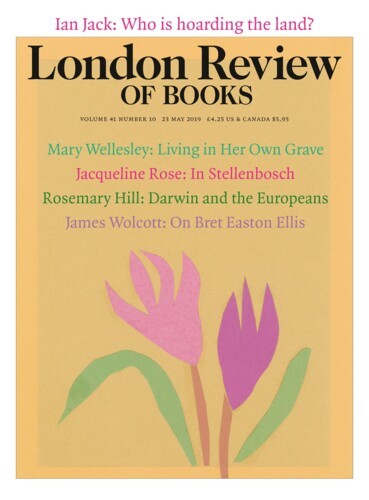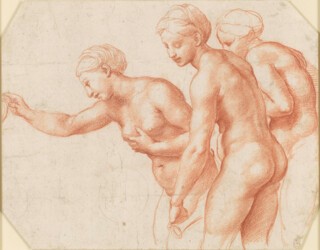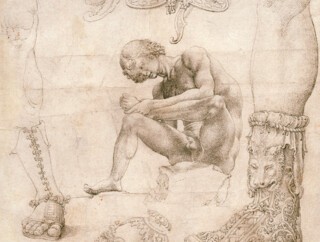The European art academies were first formed in Florence and Rome in the 16th century as professional associations devoted to raising the status of the artist above that of a craftsman, replacing the long-established guilds with institutions that would enjoy the patronage of a prince, and provide access to experts on anatomy and the complexities of linear perspective. Members would be able to reward younger talent and also – perhaps more important – exclude colleagues whom they considered unworthy (for instance painters of ornament or of flowers, sometimes watercolourists, often engravers). The Royal Academy of Arts, founded just over 250 years ago in the winter of 1768, is a late example of such an institution.
Alongside professional associations of this kind were numerous more modest and less durable academies, the main purpose of which was to organise supervised access to a model. These were often established by successful artists for the benefit of pupils and colleagues, to share the expense of employing a model, sometimes to promote collegiate criticism, and certainly, on the relatively rare occasions when female models were involved, to avoid scandal. The complex prehistory of the RA, expertly reviewed by Robin Simon in The Royal Academy of Arts: History and Collections (Yale, 2018), mentions the academy in Saint Martin’s Lane, founded by Hogarth in 1735 and run as a co-operative, as well as the academy organised by Peter Lely in London in 1673, but there must be more than a hundred earlier Continental examples, the most celebrated of which was the Accademia degli Incamminati, founded by the Carracci family in Bologna around 1582. By the time the RA was created, and chiefly because of the example of the Académie Royale in Paris, provision of life classes had also come to be a central purpose of the major art academies, and even to be identified with them (in French a secondary meaning of the word ‘académie’ is a drawing or painting from a posed nude model). The exhibition The Renaissance Nude, at the RA until 2 June, provides some evidence of the origins of this practice, while also exploring many other themes.
A point made forcefully in the exhibition and the catalogue is that the male and female nude have very different histories and significance. Raphael’s practice in his early work of studying male models in preparation for painting female as well as male figures was not unusual. There are drawings made after he moved to Rome in 1508 in which he may have referred to the nude female sculpture of antiquity, but the first drawings by him of the female nude that were certainly made from life are those in red chalk for a fresco of Cupid and Psyche that his workshop painted in the suburban villa belonging to the banker Agostino Chigi (the Farnesina, as it came to be known). The study of three nudes on display at the RA may have been intended for one of the pendentives of the vault (where we find other groups of three overlapping figures) but was eventually used for a cluster of figures incorporated rather awkwardly into the scene of the marriage feast with which the story of Cupid and Psyche concludes. The catalogue entry dismisses as ‘romantic’ the proposal that Raphael’s lover served as the model in this and related drawings but, according to Vasari, Chigi (whose own domestic arrangements were far from respectable) moved the couple into his villa so that the affair would not divert Raphael from his work.
The exact process employed by Raphael is not always obvious. Some of his models were drawn by him in poses which are hardly possible to hold (including children in active poses that they could not have held for more than a few seconds, however obedient they were). His own pupils, who executed the frescoes based on his drawings, seem to have abandoned the practice of drawing from life. Other artists deliberately departed from the norms of proportion in the interest of figurative hyperbole. In later Italian drawings in the exhibition we find Michelangelo crowning an anatomical study of a superhuman body with a small grimacing head and Parmigianino rejoicing in the apparently huge thighs of a foreshortened, recumbent model.
When the reaction against such exaggerations came, it was Raphael’s example that artists returned to – first Federico Barocci, working in Raphael’s native Urbino, and then the Carracci in Bologna and Rome. But there are few 16th-century drawings of the female nude that possess the intimacy and immediacy of Raphael’s red chalk studies. The male body was held to be the divine form; the proper object of study and veneration. Over the following two centuries, the balance shifted. The most accomplished nudes of the 19th century – the famous drawings by Ingres and Degas, say, or the less well-known ones by Alfred Stevens (who revived Raphael’s red chalk technique) – are more commonly female than male, and today a ‘nude’ is, in most contexts, presumed to be female.
The curators of The Renaissance Nude make much of some quite startling pictures of Bathsheba (in French illuminated books of the 15th century) in which her genitals are clearly depicted, but in general they accept, as examples of nudity, paintings and drawings in which the sexual organs are concealed. It is therefore a surprise to find a wall panel that implies that the history of art changed when, ‘shortly after the artist’s death in 1564’, the genitals in Michelangelo’s fresco of the Last Judgment were covered: ‘Until then the nude had flourished.’ Concern about the distraction caused by the depiction of sexual organs was not at all new. And the new academies would ensure that the nudes in the Last Judgment remained influential, despite their fig leaves, even if less copied than the ignudi – the variously posed male nudes on the chapel ceiling – which excited no censure or overpainting.
The multi-authored introduction to the huge catalogue observes that distinctions such as the naked and the nude or the Classical and the Gothic are ‘overly blunt analytical tools for a period when the depiction of the body is often experimental and fissile’. But the authors offer no sharper tools and employ the words ‘naked’ and ‘nude’ interchangeably. There is plenty of room for confusion, but surely the vulnerable and ageing frame of a penitential hermit, like the wooden sculpture of Jerome included in the exhibition, is naked, whereas Venus Anadyomene by Titian, in an attitude inspired by ancient sculpture but certainly also studied from a living model, is nude. It is a question not only of youth and beauty but of a figure that seems not to need clothing, who is ‘natural’ without it and free from awkwardness or shame. Dürer’s woodcut of men at a bathhouse from 1496, like his awkward, angular, anxious self-portrait of 1509, seems to us more ‘naked’, and more modern – akin to the work of Schiele or Lucian Freud – than his engraving of a perfectly proportioned Apollonian Adam.
The previous iteration of The Renaissance Nude in Los Angeles included a fine example of a late 15th-century Florentine drawing of studio lads in their underwear. It is natural to assume that such drawings must have been made as preparation for paintings but the catalogue convincingly suggests that they may simply have been exercises. Indeed, from the very start the poses adopted by the model may have influenced those employed in paintings and sculpture quite as much as they were made in response to standard narrative requirements. Perhaps because study from the model is now a less frequent practice, awareness of the typical character of such work has declined. This made possible the proposal, in a recent exhibition at the British Museum, that Rodin’s Age of Bronze (1875) was inspired by the very slightly similar pose of a youth in the Parthenon frieze, although the positions of the arms in Rodin’s sculpture are completely typical of an académie: one raised hand gripping a staff or sling (which Rodin excluded), the other resting on the head. What is remarkable about Rodin’s statue is the way he converted a convention arising from the difficulty of holding a pose into an embodiment of pathos. (It may have been because the pose was so suggestive of the life class that the allegation that it had been cast from a living model seemed credible.) What is true of The Age of Bronze is also surely true of Michelangelo’s ignudi. These figures, simplistically described in the catalogue as ‘twenty muscular, naked youths based on the recently discovered Belvedere torso’, certainly owe something of their heroic character to the marble fragment, but they are also studies of models in poses which can be identified with no obvious narrative action.
The study of antique sculpture is the other practice associated with the academy, where it usually meant drawing from plaster casts (which became far more readily available during the 17th century). But before that, of course, artists copied, in one way or another, the few pieces that had survived and the ever increasing number that were being excavated. It is reasonable to claim that the Medici sculpture garden in which the young Michelangelo received instruction was a sort of mini-academy for this purpose, and perhaps, before that, the studio of Lorenzo Ghiberti (an inventory of whose collection has recently been discovered and published in Burlington Magazine). In the 15th century the best known antique nude sculpture was the bronze statue of a boy pulling a thorn from his foot, the so-called Spinario (represented in this exhibition by a luxury bronze statuette and a famous drawing made by Jan Gossaert in about 1509 when it was still displayed on top of a column). Everything changed with the discovery of the Apollo Belvedere, the Belvedere torso and the Laocoön group.
These works were held to embody a canon of beauty and to provide models of ideal grace and power, which is why the student at the RA had to draw from casts before confronting the imperfections of common nature. Action and expression, which were essential for success in the painting of narrative, could be studied from sculpture more easily than from the posed model. In this respect, the casts had more life than could easily be found in the life room. In the RA’s Collections Gallery, which opened last year, we can appreciate this from the way the casts of the Belvedere torso and of the Laocoön group are displayed. The former was an example of anatomy but also of body language, because it must have been part of a tense and attentive figure. The expressions of Laocoön and his sons, when properly lit as they are here, retain the power to astonish. It is perhaps not surprising that the decline in the use of plaster casts in teaching coincided not only with a radical change in attitude towards classical sculpture but also with the decline of the prestige attached to narrative painting. It also coincided with and helped to reinforce the preference for the naked over the nude.
Send Letters To:
The Editor
London Review of Books,
28 Little Russell Street
London, WC1A 2HN
letters@lrb.co.uk
Please include name, address, and a telephone number.



